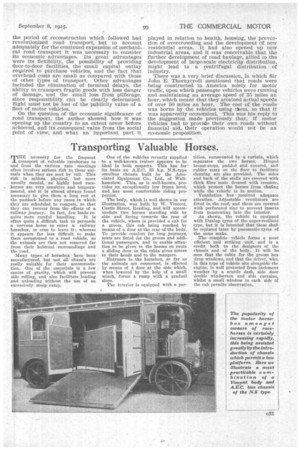Transporting Valuable Horses.
Page 15

If you've noticed an error in this article please click here to report it so we can fix it.
MHE necessity for the frequent _L transport of valuable racehorses to and from the various race meetings often involves serious risk to, these animals when they are sent by rail. This risk is seldom physical, but more usually mental, as highly bred racehorses are very sensitive and temperamental, and it is almost always found necessary to give them a long rest at the paddock before any races in which they are scheduled to compete, so that they can recover from the effects of a railway journey. In fact, few loads re
quire more careful handling. It is often quite a difficult task to persuade a nervous horse to enter a railway horsebox, or even to leave it; whereas it appears far less difficult to make them accustomed to a road vehicle, as the animals are then not removed far from their habitual surroundings and the road.
;Many types of horsebox have been., manufactured, but not all chassis are really suitable for their accommodation. One of the essentials is a low centre of gravity, which will prevent side rolling, and also facilitate loading and unloading without the use of an excessively steep ramp. One of the vehicles recently supplied to a well-known trainer appears to be ideal in both respects. This has for' its basis an A.E.C. 245 h.p. N.S.-type omnibus chassis built by the Associated Equipment Co., Ltd., of Walthamstow. This, as is well-known, provides an exceptionally low frame level, and has most comfortable riding properties.
The body, which is well shown in our1. illustration, was built by W. Vincent, Castle Street, Redding, and will accommodate two horses standing side by side and facing towards the rear of the vehicle, where is provided a cab for a groom, this cab being reached by means of a door at the rear of the body. To provide comfort for long journeys, seats are fitted for the groom and additional passengers, and to enable attention to be given to the horses en route a sliding door in the cabin gives access to their heads and to the mangers.
Entrance to the horsebox, so far as the animals are concerned, is effected by means of a door at the side which, when lowered by the help of a small winch, forms a ramp with a gradual slope.
The interior is equipped with a par
tition, surmounted by a curtain, which separates the two horses. Hinged breast-stops, padded and covered, and rubber mats on the floor to facilitate cleaning are also provided. The sides and back of the atails are covered with thick fibre mats dressed with Creosote, which protect the horses from chafing while the vehicle is in motion.
Ventilation has received adequate attention. Adjustable ventilators are fitted in the roof, and these are covered with perforated zinc to prevent insects from penetrating into the interior.
As shown, the vehicle is equipped with Dunlop tyres of the super-resilient type, but it is intended that these shall be replaced later by pneumatic tyres of the same make.
,The complete vehicle forms a most efficient and striking unit, and is a credit both to the designers of the chassis and of the body. It will be seen that the cabin for the groom has drop windows,• and that the driver, who, in this type of vehicle sits alongside the engine, is well protected from inclement weather by a scuttle dash, side door double windscreen and side curtains, whilst a small window in each side of the cab permits observation.






























